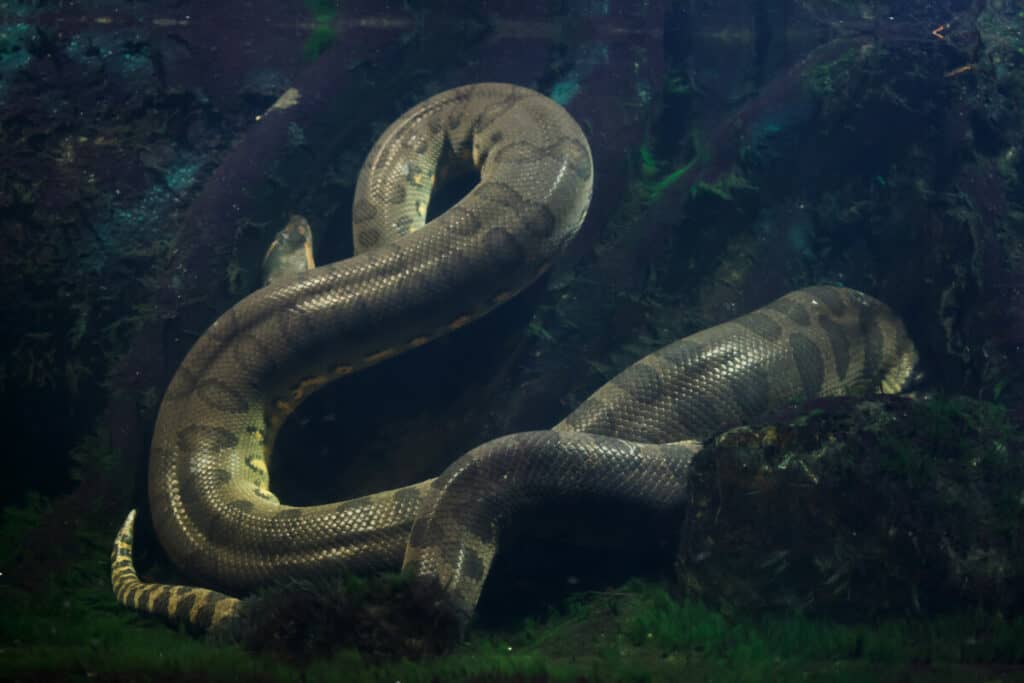
Anacondas are practically legendary snakes that a lot of people don’t know much about. If you ever watched the old Anaconda movie you might remember how fast the snake could move. But is this based in reality? How fast are anacondas actually in real life?
Anacondas can move 5 mph on land and 10 mph in the water. Humans can outrun anacondas when on land but not in water. Anacondas will hide beneath the surface of the water and ambush their prey rather than chase it down. They are not venomous and constrict their prey to kill.
There is a lot to know about the speed, size, and diet of anacondas, as well as what you should do if you see one.
Speed of Anacondas
A lot of people believe that anacondas are insanely fast and impossible to outrun, so you shouldn’t try. In reality, the truth is a bit more complicated and quite a bit less terrifying.
On land, anacondas are not very fast. They can only move about 5 miles per hour. Humans can run at an average of about 7 miles per hour. A decently fast human can outrun an anaconda on land. Of course, how fast an anaconda can move also depends on the size and age of the snake.
In the water, this is a different story. Anacondas can move about 10 miles per hour in the water. Humans can only swim 5 to 6 miles per hour, and the water in which you will come across an anaconda will be shallow and choked with plants.
If you see an anaconda in the water, head toward the land as fast as you can. Try not to go in the water if you can avoid it because it is much more dangerous. Thankfully, anacondas do not typically eat humans. That said, it is probably still not a good idea to jump in the water with an anaconda.
Anacondas typically don’t try to pursue their prey on land. Instead, they will hide just beneath or on the surface of the water, using plants to camouflage them. Then they will jump out and ambush their prey. After all, anacondas can hold their breath underwater for nearly 10 minutes.
Do Anacondas Chase Thier Prey
Anacondas will eat a variety of animals. When they are hungry, they will eat whatever animal crosses their path. This may include fish, birds, tapirs, pigs, capybaras, and more. Anacondas can even eat jaguars, though they typically only attack smaller ones.
The type of animal that an anaconda is willing to attack depends on its size. The weight of their prey can range from 10% of their body weight to 146%. Sometimes, female anacondas will even eat male anacondas after they mate.
Anacondas do not typically chase their prey. More often, they will hide out in the water to surprise prey that comes to the water to drink. They will bite the prey first; their curved teeth make it difficult for the prey to escape from the grip. Once the anaconda has restrained the prey, it will constrict the animal to kill it.
Constricting does not actually kill through suffocation or breaking the bones of the animal. The squeezing will overwhelm the circulatory system. Blood cannot get to the brain, and the animals die quickly. Either that or the prey drowns in the water.
After the prey is dead, the anaconda will swallow it whole. The jaws of an anaconda are designed so that they can open their mouths wide enough to swallow large prey. Their bodies stretch and change shape to fit the food.
Is The Anaconda The Fastest Snake
Anacondas are not the fastest snakes in the world. In fact, there are many snakes that are much faster than the anaconda. The fastest snake in the world is the sidewinder. These snakes can get move at speeds of 18 MPH! Other snakes such as the black mamba are also extremely fast and can reach speeds of 12 MPH. ( Source )
So even though the anaconda is pretty fast, it is not one of the fastest snakes. This is especially true on land. In the water, anacondas are much faster and can swim closer to 10 MPH. This is really pretty fast for a snake that size in the water.
At the end of the day, however, anacondas do not have the need to be that fast. That is at least once they have gotten to a certain size. Very few animals are capable of hunting down a full-grown anaconda. Likewise, they do not typically chase down their prey but instead, wait for them to catch them by surprise.
